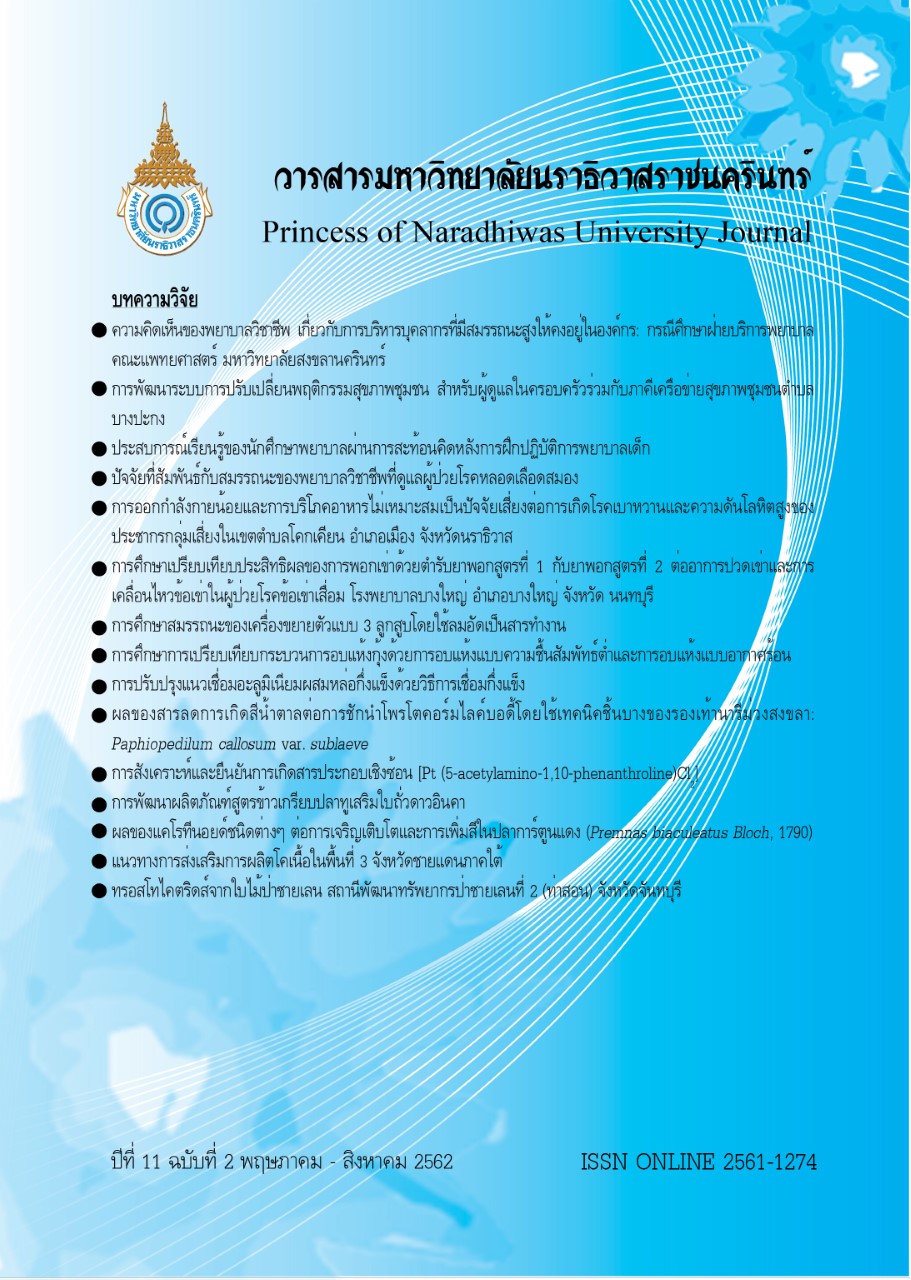สถานการณ์การดูแลผู้ป่วย ณ จุดเกิดเหตุของอาสาสมัครฉุกเฉินการแพทย์ในเขตภาคใต้
คำสำคัญ:
จุดเกิดเหต, การดูแลผู้ป่วย, อาสาสมัครฉุกเฉินการแพทยบทคัดย่อ
การวิจัยนี้เป็นการวิจัยเชิงคุณภาพ มีวัตถุประสงค์เพื่อศึกษาสถานการณ์การดูแลผู้ป่วย ณ จุดเกิดเหตุ ของอาสาสมัครฉุกเฉินการแพทย์ ในเขตภาคใต้ โดยใช้วิธีการเลือกพื้นที่แบบเจาะจง ได้แก่ จังหวัดสุราษฎร์ธานี จังหวัดนครศรีธรรมราช จังหวัดตรัง และจังหวัดยะลา การเก็บข้อมูลใช้วิธีการสนทนากลุ่มในอาสาสมัครฉุกเฉินการแพทย์ ที่ขึ้นทะเบียนเป็นผู้ปฏิบัติการแพทย์ฉุกเฉิน จังหวัดละ 10 คน รวม 40 คน และการสัมภาษณ์เชิงลึก (in-depth interview) ได้แก่ หัวหน้าศูนย์รับแจ้งเหตุ จังหวัดละ 1 คน หัวหน้าศูนย์กู้ภัยหรือมูลนิธิ จังหวัดละ 2 คน หัวหน้าห้องอุบัติเหตุฉุกเฉิน โรงพยาบาลศูนย์หรือโรงพยาบาลทั่วไป จังหวัดละ 2 คน รวม 20 คน โดยกลุ่มตัวอย่างทั้งหมดใช้วิธีการเลือกแบบเจาะจง แล้วนำมาวิเคราะห์ด้วยวิธีวิเคราะห์เนื้อหา การวิจัยนี้เป็นการวิจัยเชิงคุณภาพ มีวัตถุประสงค์เพื่อศึกษาสถานการณ์การดูแลผู้ป่วย ณ จุดเกิดเหตุ ของอาสาสมัครฉุกเฉินการแพทย์ ในเขตภาคใต้ โดยใช้วิธีการเลือกพื้นที่แบบเจาะจง ได้แก่ จังหวัดสุราษฎร์ธานี จังหวัดนครศรีธรรมราช จังหวัดตรัง และจังหวัดยะลา การเก็บข้อมูลใช้วิธีการสนทนากลุ่มในอาสาสมัครฉุกเฉินการแพทย์ ที่ขึ้นทะเบียนเป็นผู้ปฏิบัติการแพทย์ฉุกเฉิน จังหวัดละ 10 คน รวม 40 คน และการสัมภาษณ์เชิงลึก (in-depth interview) ได้แก่ หัวหน้าศูนย์รับแจ้งเหตุ จังหวัดละ 1 คน หัวหน้าศูนย์กู้ภัยหรือมูลนิธิ จังหวัดละ 2 คน หัวหน้าห้องอุบัติเหตุฉุกเฉิน โรงพยาบาลศูนย์หรือโรงพยาบาลทั่วไป จังหวัดละ 2 คน รวม 20 คน โดยกลุ่มตัวอย่างทั้งหมดใช้วิธีการเลือกแบบเจาะจง แล้วนำมาวิเคราะห์ด้วยวิธีวิเคราะห์เนื้อหา ผลการวิจัยพบว่า การดูแลผู้ป่วย ณ จุดเกิดเหตุของอาสาสมัครฉุกเฉินการแพทย์ ในเขตภาคใต้สิ่งที่ส่งผลต่อสถานการณ์ในการการปฏิบัติงาน ได้แก่ 1) ความรู้ความสามารถของเจ้าหน้าที่อาสาสมัครฉุกเฉินการแพทย์ โดยเฉพาะประเด็นการนำความรู้จากการอบรมไปใช้ในทางปฏิบัติจริง 2) ศักยภาพ คุณภาพ และความเพียงพอของอุปกรณ์/สิ่งของในการช่วยเหลือผู้บาดเจ็บจากยานพาหนะ 3) สภาพแวดล้อมที่กดดันต่อการทำงาน ณ จุดเกิดเหตุ และ 4) สื่อออนไลน์ที่ส่งผลด้านบวกและด้านลบต่อการเข้าช่วยเหลือผู้ป่วย ดังนั้น หน่วยงานที่เกี่ยวข้องควรหาวิธีการหรือแนวทางเพิ่มเติมเพื่อเพิ่มศักยภาพ ความพร้อม รวมทั้งเพิ่มกฎระเบียบที่เอื้อประโยชน์ต่อการปฏิบัติงาน ณ จุดเกิดเหตุของอาสาสมัครฉุกเฉินการแพทย์
เอกสารอ้างอิง
Journal of the Medical Association of Thailand, 92, 7-9.
Emergency Department, Konkhan Hospital, (2013). Statistics of EMS service and ER Visit at Hospital nder Office of the Permanent Secretary. Konkhan Hospital. (in Thai)
Kansakorn, N., Silawan T., Rawivorakul T., Kittipichai Waritt,. & Laothong A., (2016). The Study on Emergency
Medical Service For The Elderly. National Institute for Emergency Medicine. Retrieve 10 March 2018 from: https://www.niems.go.th/th/Upload/File/255911291527463047 _276dqvbz2kfisI9b.pdf
Kumkong, M. & Nawsuwan, K. (2017). Guideline for Developing Quality and Safety in Caring for Patients with Accident and Emergency. EAU Heritage Journal Science and Technology, 11(3), 30-42.
Leonard, J.C., Scharff, D.P., Koors, V., Lerner, B., Adelgais, K.M., Anders, J., ... Jaffe, D.M. (2012). A Qualitative Assessment of Factors That Influence Emergency Medical Services Partnerships in Prehospital Research. Academic Emergency Medicine, 19,161-173.
Lertsakornsiri, M., Deoisres, W., & Suwaree, S. (2012). Factors Associated with the Performance of Clinical Practice in Obstetrics Nursing Among Nursing Students in Private Institutions. Journal of Nursing Science and Health, 35(2), 91-99
Nonaka, I. & Takeuchi, H. (1995). The knowledge-creating company. New York, Oxford: Oxford University Press.
National Emergency Medicine Act. (2008). National Emergency Medicine Institute. Retrieve 2 June 2018 from: https://www.niems.go.th/th/View/Page.aspx?PageId=25560110092228962
National Health Act, B.E. 2550. (2007). Retrieve 2 2018 from: http://www.acfs.go.th/km/download/act_ healthy_2550.pdf
National Institute for Emergency Medicine. (2012). Emergency Medical Operation Manual for FirstResponder Unit (2nd ed.). Bangkok : N P Press Limited Partnership. (in Thai)
National Institute for Emergency Medicine, Ministry of Public Health. (2018). Institute for Emergency Medicine. Retrieve 2 June 2018 from: https://ws.niems.go.th/ITEMS_DWH/
Na Ubon, A. (2013). The Knowledge Creating Company: How Japanese Companies Create the Dynamics of Innovation. Retrieve 10 March 2018 from: http://www.dpu.ac.th/dpurc/assets/uploads/ magazine/fakxaj2o2p4o8co.pdf
Patthanapreechawong, N., Sinthavalai, R., & Memongkol, N. (2012). Development of a Pre-hospital Care Emergency Medical Operations System. KKU Research Journal, 17(6), 911-932.
Srichan, S. (2017). Legal Measures for Disputes Resolution in case of Tort from Medical Services. Retrieve 10 March 2018 from: http://dspace.spu.ac.th/handle/123456789/5522
Strategy and Planning Division. (2015). Office of the Permanent Secretary, Ministry of Public Health.
Sutapak, T. (2014). Evaluating Emergency Medical Services of Ubon Rachathani Province. Local Administration Journal, 8(3), 10-18
Suwanarat, A., Suwanarat, S., Papila, N., Huhnakarn, R., Chusang, S., & Somton, A. (2015). Gap of Thai Emergency Medicine : Situation of Emergency Medicine By 2014. National Institute for Emergency Medicine. Nontaburi: Pajamitr Publishing. (in Thai)




